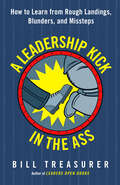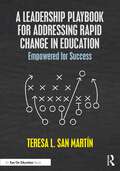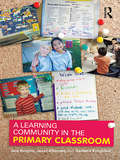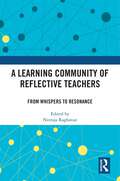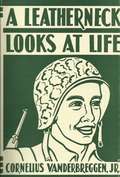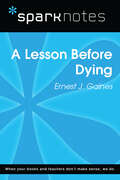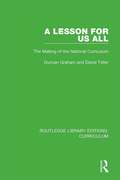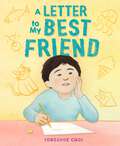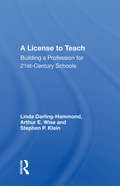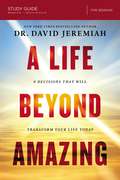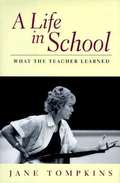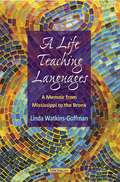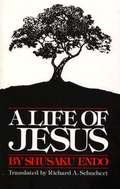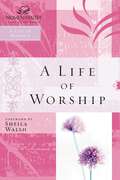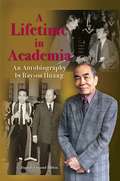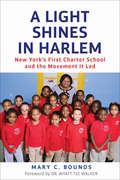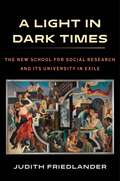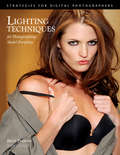- Table View
- List View
A Leadership Guide to Navigating the Unknown in Education: New Narratives Amid COVID-19
by Sally J. Zepeda Philip D. LanoueRecognizing that education systems have been temporarily paralyzed in the past and likely will in the future—whether it’s because of a natural disaster or a pandemic—this important volume offers critical insights about how schools can effectively carry forward the mission of educating all children even in the face of system turbulence and disruption. Featuring Narratives from expert leaders in urban, rural, and suburban school systems, this book explores important questions about the "new normal" such as the ways in which students can and should learn, how educators can teach and lead effectively, and how schools can carry out important functions beyond their instructional mission. Chapters present inspiring stories of leaders and teachers who have rallied, rebuilt, and problem-solved in face of the pandemic and amid adversity, ultimately providing a roadmap for how it’s possible to rebuild and adjust while preserving the fundamental core of education. Full of takeaways and first-hand insights into how systems and their schools faced turbulence, disruption, and adaptation, this book is a must-read for today’s educators committed to making a positive impact on the students they have the duty to serve.
A Leadership Kick in the Ass: How to Learn from Rough Landings, Blunders, and Missteps
by Bill Treasurer"This is one of the most unique and valuable books you will read all year, and I highly recommend it."—Jim Kouzes, coauthor of the bestselling and award-winning The Leadership Challenge and Dean's Executive Fellow of Leadership, Leavey School of Business, Santa Clara UniversityEven the best leaders—in fact, most of the best leaders—start out as decidedly bad ones. And sooner or later they reach a moment of reckoning that leadership expert Bill Treasurer calls the leadership kick in the ass. When it happens, it feels like it's all over. But Treasurer says that with the right attitude, that kick can be a new beginning. Based on his work with thousands of leaders, this book reveals how to turn those ego-bruising events into the kind of transformative experiences that mark the paths of great leaders. As Steve Jobs famously said, "Getting fired was the best thing that ever happened to me." This book is a survival guide, coach, and morale booster to help you use that kick to move forward instead of fall down. If you succeed, the next place you get kicked might be upstairs.
A Leadership Playbook for Addressing Rapid Change in Education: Empowered for Success
by Teresa L. San MartinA Leadership Playbook for Addressing Rapid Change in Education provides educational leaders with a simple, step-by-step approach for addressing rapid change. Drawing on the model of appreciative inquiry, this book provides detailed examples of educational problems and provides the who, what, where, when, why, and how to achieve change. Author Teresa L. San Martín emphasizes the traits of outstanding and exceptional leaders: trust; collaborative efforts; communicating with empathy and care. Detailed play-by-play examples are provided that show how school administrators are able to solve relevant problems of practice such as how to create productive and focused high school teacher teams, how educational leaders can increase teacher retention, and how district administrators can provide innovative and meaningful staff development opportunities. This timely book—which supports educators as they continue to grapple with the effects of the pandemic—provides real solutions, equipping school administrators with the tools necessary to confront perpetual change occurring in today’s complex educational environment.
A Leadership Shift: Culture Transformation Towards Organisational Oneness
by Dr Nahla Khaddage Bou-DiabRooted in over 40 years of seasoned experience and rigorous scholarly research, A Leadership Shift beckons leaders towards a courageous transformation in organizational ethos. This pioneering narrative seamlessly translates intricate scholarly theories into a practical, proven implementation methodology, illuminated through a real-world case study. It’s the first of its kind, melding profound subjects like organizational oneness, quantum field linkage to leadership, the human biofield’s potency, and the ripple effects of thoughts and spiritual emotions in the workplace, into a comprehensible step-by-step methodology for leaders. The discourse extends into gender diversity and the ramifications of women empowerment programs, converging multiple facets into a singular vista. While various scholars have shed light on the subjects broached in this book, its distinctiveness emanates from melding science with practical experience and morphing it into a tangible methodology to tackle genuine organizational challenges. A Leadership Shift not only unveils the science of evolving a culture to attain organizational oneness but invites readers to perceive the human dynamo from a fresh lens and foster a leadership metamorphosis to unlock workplace potential. It demystifies the science and the method, making it accessible for leaders to adopt and apply sans complexity. Offering a structured methodology to aid leaders in overhauling organizational culture and ingraining change capabilities within the system, this book elucidates the methodology, provides a meticulous depiction of its implementation, and the ensuing outcomes. Bolstered by over 160 scholarly citations, four decades of global know-how, and academic action research, A Leadership Shift demonstrates the profound impact of this methodology on organizational performance, fuelled by an enhanced sense of belonging within the organization.
A Learning Community in the Primary Classroom
by Barbara Knighton Jere Brophy Janet AllemanThis richly detailed description and analysis of exemplary teaching in the primary grades looks at how a teacher establishes her classroom as a collaborative learning community, how she plans curriculum and instruction that features powerful ideas and applications to life outside of school, and how, working within this context, she motivates her students to learn with a sense of purpose and thoughtful self-regulation. The supporting analyses, which ground the teacher’s practice in principles from curriculum and instruction, educational psychology, and related sources of relevant theory and research, are designed to allow teacher-readers to develop coherent understanding and appreciation of the subtleties of her practice and how they can be applied to their own practice. Resulting from a lengthy collaboration among an educational psychologist, a social studies educator, and a classroom teacher, the aspects and principles of good teaching this book details are widely applicable across elementary schools, across the curriculum, and across the primary grade levels. To help readers understand the principles and adapt them to their particular teaching situations, an Appendix provides reflection questions and application activities.
A Learning Community of Reflective Teachers: From Whispers to Resonance
by Neeraja RaghavanTeachers possess a wealth of untapped wisdom and valuable experience. Whether it’s in matter of educational policy, curriculum development or textbook selection, teachers carry a trove of information and insights to share. Traditionally, teacher development has been driven by administrators of schools, and it often takes the form of a ‘mentor’ teaching the staff of a school. But what happens when teachers across different locations collaborate and learn together? This volume documents such an initiative, sparked off by the Covid-19 pandemic, which brought people together online. It underscores the power of teachers debating, discussing, and learning from each other. Based on an Indian experience, the book addresses a range of issues teachers and educators face across the world — encompassing pedagogy, classroom management, school culture and teacher development. A unique story of community building and teacher education, this book also contains key outcomes and insights which take us through their action research projects and showcases a model of teacher development that can be adopted by interested readers. Above all, it brings out the crying need for a teacher’s voice to be heard — for far too long, teachers have been mere implementers of decisions taken by policy makers or managements of schools. By means of networking communities such as the one described in this book, the transformation of teachers going from whispers to resonance is greatly amplified. An important intervention in the domain of teacher development, this volume will be of great interest to students, researchers and practitioners of education, teacher education, and sociology of education. It will also be useful for teacher trainees, academicians, teacher educators, policymakers, schoolteachers, curriculum developers, teacher training institutes, and universities offering teacher education programs.
A Leatherneck Looks At Life
by 2nd Lt. Cornelius Vanderbreggen Jr.The story of a WWI marine's journey to finding everlasting peace, which he finally finds in Jesus.
A Lesson Before Dying (SparkNotes Literature Guide Series)
by SparkNotesA Lesson Before Dying (SparkNotes Literature Guide) by Ernest J. Gaines Making the reading experience fun! Created by Harvard students for students everywhere, SparkNotes is a new breed of study guide: smarter, better, faster. Geared to what today's students need to know, SparkNotes provides: *Chapter-by-chapter analysis *Explanations of key themes, motifs, and symbols *A review quiz and essay topicsLively and accessible, these guides are perfect for late-night studying and writing papers
A Lesson For Us All: The Making of the National Curriculum (Routledge Library Editions: Curriculum #13)
by Duncan Graham David TytlerOriginally published in 1993. "A Lesson for Us All" tells of the intrigue and pressures that surrounded the introduction of the National Curriculum, the most sweeping educational reform since 1944, and examines the roles of three education secretaries: Kenneth Baker, John MacGregor and Kenneth Clarke. Duncan Graham was the man charged with introducing the new-style lessons into the 24,000 state schools in England and Wales from 1988 to 1991 when he resigned as Chairman and Chief Executive of the National Curriculum Council after deep divisions over principles with Kenneth Clarke, the Education Secretary. In collaboration with David Tytler, former Education Editor of "The Times", Mr Graham tells of the struggles with ministers, civil servants and the teacher unions to introduce the new style lessons to a tight timetable set by the Government.
A Letter to My Best Friend
by Yangsook ChoiFrom Yangsook Choi comes an empowering picture book about a child learning a new language to keep in touch with an old friend.Today is the day I’ll make friends.At least, that’s what I promise myself.Jihun recently moved to the United States. In his new classroom, he receives an assignment to write a letter to his best friend—but he’s not sure how it will turn out. First off, he’s still learning English. Second, he doesn’t have any friends at school yet. What’s more, his best friend back in Korea can’t read.Fueled by wonderful memories of his former home, Jihun uses his creativity to craft a letter for his best friend, Oto. The result is nothing short of extraordinary and opens a door for Jihun to make new friends.
A Letter to My Teacher
by Deborah HopkinsonThis funny, touching picture book celebrates the difference a good teacher can make. Written as a thank-you note to a special teacher from the student who never forgot her, this moving story makes a great classroom read-aloud, and a perfect back-to-school gift for students and teachers! Dear Teacher, Whenever I had something to tell you, I tugged on your shirt and whispered in your ear. This time I&’m writing a letter. So begins this heartfelt picture book about a girl who prefers running and jumping to listening and learning—and the teacher who gently inspires her. From stomping through creeks on a field trip to pretending to choke when called upon to read aloud, this book&’s young heroine would be a challenge to any teacher. But this teacher isn&’t just any teacher. By listening carefully and knowing just the right thing to say, she quickly learns that the girl&’s unruly behavior is due to her struggles with reading. And at the very end, we learn what this former student is now: a teacher herself. From award winning author Deborah Hopkinson and acclaimed illustrator Nancy Carpenter, this picture book is made to be treasured by both those who teach and those who learn.
A Level Mathematics: First Aid Kit
by Sophie Goldie Rose JewellMaster essential skills and boost progress in A-level Maths with extra support and practice for every topic. This book provides structured guidance through clear explanations, worked examples and practice questions.- Improve understanding with clear explanations, worked examples and links that highlight relationships between topics- Put skills into practice and check understanding with skills-focused and problem-solving questions, plus carefully structured multiple-choice questions with detailed answers online that explain each correct and incorrect answer- Build confidence and develop awareness of potential misconceptions with 'Be the examiner' exercises- Learn to apply GCSE knowledge to A-level concepts with questions that bridge the gap between Key Stages 4 and 5- Identify and avoid common mistakes with worked solutions in the back of the book- Develop advanced calculator skills with links to extra online material designed to enhance understanding and develop checking strategies using a graphical calculator
A Lever Long Enough: A History of Columbia's School of Engineering and Applied Science Since 1864 (Columbiana)
by Robert McCaugheyIn this comprehensive social history of Columbia University's School of Engineering and Applied Science (SEAS), Robert McCaughey combines archival research with oral testimony and contemporary interviews to build a critical and celebratory portrait of one of the oldest engineering schools in the United States. McCaughey follows the evolving, occasionally rocky, and now integrated relationship between SEAS's engineers and the rest of the Columbia University student body, faculty, and administration. He also revisits the interaction between the SEAS staff and the inhabitants and institutions of the City of New York, where the school has resided since its founding in 1864. McCaughey compares the historical struggles and achievements of the school's engineers with their present-day battles and accomplishments, and he contrasts their teaching and research approaches with those of their peers at other free-standing and Ivy League engineering schools. What begins as a localized history of a school striving to define itself within a university known for its strengths in the humanities and the social sciences becomes a wider story of the transformation of the applied sciences into a critical component of American technology and education.
A Liberal Vocationalism
by John Brennan Harold SilverAims to rescue a usable interpretation of the vocational theory in higher education by describing the historical and policy frameworks of the debate.
A License To Teach: Building A Profession For 21st Century Schools
by Linda Darling-HammondA License to Teach speaks directly to the quality-of-education debate now focused on public schools. It shows that reforms of teacher education and licensing are needed to ensure that teachers are prepared for the classroom.
A Life Beyond Amazing Study Guide: 9 Decisions That Will Transform Your Life Today
by David JeremiahWhy were people in the first century so drawn to Jesus of Nazareth? His powerful miracles and challenging teachings, for sure. But it was also His character. Humanity had never witnessed someone who is loving, joyful, peaceful, patient, compassionate, generous, faithful, humble, and self-controlled all the time. It was as if God Himself had become a human being to demonstrate the life that is possible–a life beyond amazing.The traits that Jesus demonstrated in His life were traits empowered by the Spirit of God who filled Him. When Jesus returned to heaven, He sent His Spirit to indwell all His true followers so they could display the same character in their lives–not for their benefit alone but to show the world the kind of life God intended us to enjoy. The apostle Paul called these traits "the fruit of the Spirit" (Galatians 5:22–23).In this A Life Beyond Amazing Study Guide, Dr. David Jeremiah describes the divinely empowered life that is possible for followers of Christ. Between introductory and concluding messages, Dr. Jeremiah explores each of the nine traits of a Spirit-filled life as outlined by the apostle Paul–traits that produce a life beyond amazing. Each lesson also includes:An outline of the main subjects and Scriptures covered during the lessonAn overview of Dr. Jeremiah's teaching on the topic being studiedApplication questions to help individuals and small groups delve into the BibleA Did You Know? section that adds a point of interest to the lesson
A Life In School: What The Teacher Learned
by Jane TompkinsIn this text, one of America's leading literary scholars looks back on her own life in the classroom, and discovers how much of what she learned there needs to be unlearned. Jane Tompkins's memoir shows how her education shaped her in the mold of a high achiever who could read five languages but had little knowledge of herself. As she slowly awakens to the needs of her body, heart, and spirit, she discards the conventions of classroom teaching and learns what her students' lives are like. A story of spiritual awakening, Tompkins' book critiques our educational system while also paying tribute to it.
A Life Teaching Languages
by Linda Watkins-GoffmanEveryone faces crossroads. While not everyone meets at the same crossroads, we all juggle multiple identities. It is these roles--sometimes conflicting and other times fitting together seamlessly--that Linda Watkins-Goffman explores in A Life Teaching Languages: A Memoir from Mississippi to the Bronx. In this memoir of an educator, Watkins-Goffman offers insights she has gained from her years of traveling, teaching, and writing and shares how her experiences have shaped her teaching philosophy. According to Watkins-Goffman, teachers must communicate authentically to teach effectively and, to accomplish this, they must connect their own experiences in some way with those of their students. The stories she tells are sure to resonate with pre-service and practicing teachers alike. Her reflections about her own experiences will be useful to readers who plan to become ESL educators, or those who simply seek inspiration about teaching.
A Life in Motion (Jewish Women Writers Ser.)
by Florence Howe&“A sharp and compelling memoir&” of a feminist icon who forged positive change for herself, for women everywhere, and for the world (Rosemary G. Feal, executive director of the Modern Language Association). Florence Howe has led an audacious life: she created a freedom school during the civil rights movement, refused to bow to academic heavyweights who were opposed to sharing power with women, established women&’s studies programs across the country during the early years of the second wave of the feminist movement, and founded a feminist publishing house at a time when books for and about women were a rarity. Sustained by her relationships with iconic writers like Grace Paley, Tillie Olsen, and Marilyn French, Howe traveled the world as an emissary for women&’s empowerment, never ceasing in her personal struggle for parity and absolute freedom for all women. Howe&’s &“long-awaited memoir&” spans her ninety years of personal struggle and professional triumphs in &“a tale told with startling honesty by one of the founding figures of the US feminist movement, giving us the treasures of a history that might otherwise have been lost&” (Meena Alexander, author of Fault Lines).
A Life of Jesus
by Shusaku Endo Richard A. SchuchertA simple and powerful retelling of the life of Christ as seen through the eyes of a Japanese novelist. A profound and beautiful life of Jesus with many of the novelist-author's opinions.
A Life of Worship (Women of Faith Study Guide Series)
by Women Of FaithFilling the needs of today's women, we offer the next 4 titles in the best-selling Women of Faith series.These topical guides deal with issues that women wrestle with today, such as friendship, encouragement, managing moods, finding contentment, and how to live out your faith. Reaching an audience across racial, socio-economic, denominational, and age boundaries, these guides will enhance the lives of women as they empower them in their weekly devotions. The study guides can be used for both individual and group settings. Women are asking good questions about their faith. With our study guides, we want to join them in their quest for knowledge and lead them in finding the answers they are seeking. The Study Guide Series will include the following:#5 Managing Your Moods - Foreword by Marilyn Meberg ISBN: 0-7852-5151-0#6 Cultivating Contentment - Foreword by Luci Swindoll ISBN: 0-7852-5152-9#7 Encouraging One Another - Foreword by Nicole Johnson ISBN: 0-7852-5153-7#8 A Life of Worship - Foreword by Sheila Walsh ISBN: 0-7852-5154-5
A Lifetime in Academia
by Rayson HuangRayson Huang began his studies at the University of Hong Kong in 1938. Thirty-four years later, in 1972, he became the University's first Chinese Vice-Chancellor and served in that position until 1986. He sat on the Legislative Council of Hong Kong and on the Drafting Committee that formulated China's Basic Law for Hong Kong after its return to China in 1997. In this lively and frank autobiography, Huang reflects on his diverse university career of almost half a century - in Hong Kong, China, Britain, the United States, Singapore and Malaysia - and on his experiences during World War II, when he moved, as a refugee, into Free China to study and teach. This expanded second edition includes substantial additional material on his childhood, his experiences in occupied Hong Kong, and his activities as vice-chancellor.
A Light Shines in Hrlem: New York's First Charter School and the Movement It Led
by Mary Bounds Wyatt WalkerA Light Shines in Harlem tells the fascinating history of New York's first charter school, the Sisulu-Walker Charter School of Harlem, and the early days of the state's charter school movement. Told through the experiences of those on the inside--including a hero of the civil rights movement; a Wall Street star; inner-city activists; and real-world educators, parents, and students--this book shows how they all came together to create a groundbreaking school that, in its best years, far outperformed public schools in the neighborhoods in which most of its children lived. It also looks at education reform through a broader public policy lens, discussing recent research and issues facing the charter movement today, describing what makes a public charter school--or any school--succeed or fail, and showing how these lessons can be applied to other public and private schools to make all of them better. The end result is not only an exciting narrative of how one school fought to succeed, but also an illuminating glimpse into the future of education in the United States.
A Light in Dark Times: The New School for Social Research and Its University in Exile
by Judith FriedlanderThe New School for Social Research opened in 1919 as an act of protest. Founded in the name of academic freedom, it quickly emerged as a pioneer in adult education—providing what its first president, Alvin Johnson, liked to call “the continuing education of the educated.” By the mid-1920s, the New School had become the place to go to hear leading figures lecture on politics and the arts and recent developments in new fields of inquiry, such as anthropology and psychoanalysis. Then in 1933, after Hitler rose to power, Johnson created the University in Exile within the New School. Welcoming nearly two hundred refugees, Johnson, together with these exiled scholars, defiantly maintained the great traditions of Europe’s imperiled universities.Judith Friedlander reconstructs the history of the New School in the context of ongoing debates over academic freedom and the role of education in liberal democracies. Against the backdrop of World War I and the first red scare, the rise of fascism and McCarthyism, the student uprisings during the Vietnam War and the downfall of communism in Eastern Europe, Friedlander tells a dramatic story of intellectual, political, and financial struggle through illuminating sketches of internationally renowned scholars and artists. These include, among others, Charles A. Beard, John Dewey, José Clemente Orozco, Robert Heilbroner, Hannah Arendt, and Ágnes Heller. Featured prominently as well are New School students, trustees, and academic leaders. As the New School prepares to celebrate its one-hundredth anniversary, A Light in Dark Times offers a timely reflection on the legacy of this unique institution, which has boldly defended dissident intellectuals and artists in the United States and overseas.
A Lighting Techniques for Photographing Model Portfolios
by Billy PegramDetailed discussions and eye-catching, dynamic images show photographers how to masterfully create beautifully illuminated models in this professional, informative resource. With an endless array of looks for all types of models—such as nude, athletic, advertising, hand, leg, and plus size—this manual is packed with inspiration as well as technical advice Start-to-finish analyses of real-life sessions help photographers take the guesswork out of lighting and avoid common mistakes. Whether enhancing a product with the model or showcasing the model with the photograph, these tips illustrate how to meet objectives through artistry and skill.

